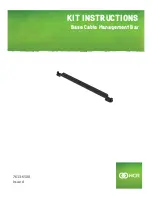
Figure 38. The TCC selection setpoints.
Set the
Inverse Segment
setpoint to “None” for each selected element in each of the
TCCs for Test.
Note:
When using the
TCC Shifting
feature, the options in the
For Close Operations
and
For Pulse Operations
setting in the
Setup>Protection>General Profile n>
Direction n Current TCCs for Test Sequence-Test n
screen sections must be set to the
Use New TCCs, with all elements completely reset
setting. See Figure 38.
For all PulseFinding technique-configured IntelliRupter fault interrupters, set the
Inverse Segment
setpoint to “None” for each of the selected elements in each of the
TCCs for Test Sequence - Test n sections.
Note:
n = 1 through 4.
Set the
Test-n Delay
setpoint of the adjacent downstream IntelliRupter fault inter-
rupter to be greater than or equal to the longer of
Test TCC Hold Time
se
Definite Time 1 Min. Time
se 0.1 seconds or
Test TCC Hold Time
setpoint
+
Definite Time 2 Min. Time
se 0.1 seconds.
Note:
n = 1 through 4.
TCC Shifting check box
Select this check box to enable faster and more sensitive TCCs for Test Sequence to be
momentarily used after a
PulseClosing Technology
operation and then closing. TCCs
for test sequence remain active for the user-selectable
Test TCC Hold Time
setpoint.
After the PulseClosing Technology and then closing events, and provided all TCCs for
Test Sequence
elements are quiet and the
Test TCC Hold Time
has expired, TCCs
for Test Sequence de-assert, and the slower Initial Trip TCCs re-assert. Use this feature
when using the PulseFinding technique on a system prone to reinitiating faults.
Test TCC Hold Time
The
Test TCC Hold Time
setpoint controls when the TCCs for Test Sequence are active.
When the Test TCC Hold Time expires and provided all TCCs for
Test Sequence
elements
are quiet, the TCCs for Test Sequence de-assert and the Initial Trip TCCs re-assert.
This time value should provide faults that reinitiate, e.g., tree limbs, adequate time to
redevelop after a circuit is reenergized. This time value plus the maximum response
time of any TCCs for Test Sequence Test-n should also be less than the
Test-n Delay
setpoint of the adjacent downstream IntelliRupter fault interrupter.
Note:
n = 1 through 4.
(Range: 0.2-300; Step: 0.1; Default: 0.8)
This setting must be shorter than the shortest delay time of the test sequence config-
ured in the downstream or down line-device that has the PulseFinding technique enabled.
S&C recommends the same delay times be used at all the devices with the PulseFinding
technique enabled.
54 S&C Instruction Sheet 766-530
Protection Setup
















































